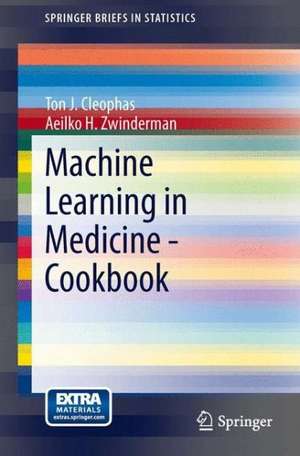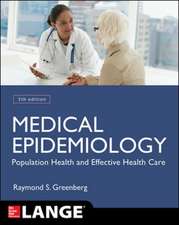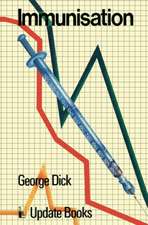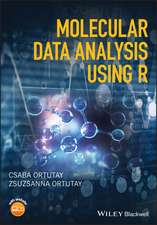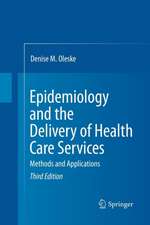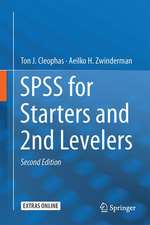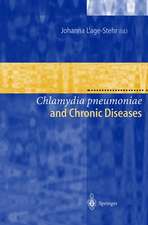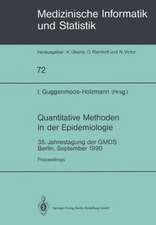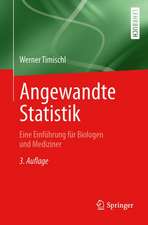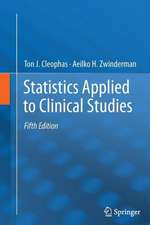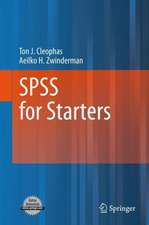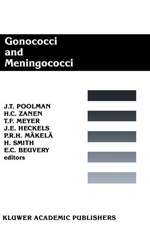Machine Learning in Medicine - Cookbook: SpringerBriefs in Statistics
Autor Ton J. Cleophas, Aeilko H. Zwindermanen Limba Engleză Paperback – 14 ian 2014
Obviously, it is time that medical and health professionals mastered their reluctance to use machine learning and the current 100 page cookbook should be helpful to that aim. It covers in a condensed form the subjects reviewed in the 750 page three volume textbook by the same authors, entitled “Machine Learning in Medicine I-III” (ed. by Springer, Heidelberg, Germany, 2013) and was written as a hand-hold presentation and must-read publication. It was written not only to investigators and students in the fields, but also to jaded clinicians new to the methods and lacking time to read the entire textbooks.
General purposes and scientific questions of the methods are only briefly mentioned, but full attention is given to the technical details. The two authors, a statistician and current president of the International Association of Biostatistics and a clinician and past-president of the American College of Angiology, provide plenty of step-by-step analyses from their own research and data files for self-assessment are available at extras.springer.com.
From their experience the authors demonstrate that machine learning performs sometimes better than traditional statistics does. Machine learning may have little options for adjusting confounding and interaction, but you can add propensity scores and interaction variables to almost any machine learning method.
Din seria SpringerBriefs in Statistics
-
 Preț: 378.34 lei
Preț: 378.34 lei - 15%
 Preț: 459.93 lei
Preț: 459.93 lei - 17%
 Preț: 359.75 lei
Preț: 359.75 lei -
 Preț: 411.54 lei
Preț: 411.54 lei -
 Preț: 445.88 lei
Preț: 445.88 lei -
 Preț: 445.33 lei
Preț: 445.33 lei -
 Preț: 378.71 lei
Preț: 378.71 lei -
 Preț: 375.23 lei
Preț: 375.23 lei -
 Preț: 378.71 lei
Preț: 378.71 lei -
 Preț: 350.50 lei
Preț: 350.50 lei -
 Preț: 378.54 lei
Preț: 378.54 lei -
 Preț: 378.71 lei
Preț: 378.71 lei - 15%
 Preț: 461.73 lei
Preț: 461.73 lei -
 Preț: 352.28 lei
Preț: 352.28 lei -
 Preț: 378.54 lei
Preț: 378.54 lei -
 Preț: 377.73 lei
Preț: 377.73 lei - 5%
 Preț: 360.70 lei
Preț: 360.70 lei -
 Preț: 351.42 lei
Preț: 351.42 lei -
 Preț: 378.92 lei
Preț: 378.92 lei -
 Preț: 375.07 lei
Preț: 375.07 lei -
 Preț: 342.74 lei
Preț: 342.74 lei -
 Preț: 444.35 lei
Preț: 444.35 lei -
 Preț: 414.42 lei
Preț: 414.42 lei - 15%
 Preț: 462.70 lei
Preț: 462.70 lei -
 Preț: 378.54 lei
Preț: 378.54 lei -
 Preț: 378.12 lei
Preț: 378.12 lei -
 Preț: 271.46 lei
Preț: 271.46 lei -
 Preț: 347.71 lei
Preț: 347.71 lei -
 Preț: 377.73 lei
Preț: 377.73 lei -
 Preț: 270.74 lei
Preț: 270.74 lei -
 Preț: 378.54 lei
Preț: 378.54 lei - 5%
 Preț: 327.04 lei
Preț: 327.04 lei -
 Preț: 377.18 lei
Preț: 377.18 lei -
 Preț: 273.40 lei
Preț: 273.40 lei -
 Preț: 377.18 lei
Preț: 377.18 lei -
 Preț: 379.30 lei
Preț: 379.30 lei -
 Preț: 376.59 lei
Preț: 376.59 lei -
 Preț: 379.68 lei
Preț: 379.68 lei -
 Preț: 272.04 lei
Preț: 272.04 lei -
 Preț: 378.54 lei
Preț: 378.54 lei -
 Preț: 379.09 lei
Preț: 379.09 lei -
 Preț: 446.26 lei
Preț: 446.26 lei -
 Preț: 375.84 lei
Preț: 375.84 lei -
 Preț: 344.14 lei
Preț: 344.14 lei -
 Preț: 348.72 lei
Preț: 348.72 lei -
 Preț: 377.95 lei
Preț: 377.95 lei -
 Preț: 269.71 lei
Preț: 269.71 lei - 5%
 Preț: 361.06 lei
Preț: 361.06 lei -
 Preț: 375.84 lei
Preț: 375.84 lei -
 Preț: 442.62 lei
Preț: 442.62 lei
Preț: 360.86 lei
Preț vechi: 379.86 lei
-5% Nou
Puncte Express: 541
Preț estimativ în valută:
69.07€ • 74.55$ • 57.91£
69.07€ • 74.55$ • 57.91£
Carte tipărită la comandă
Livrare economică 19 aprilie-03 mai
Preluare comenzi: 021 569.72.76
Specificații
ISBN-13: 9783319041803
ISBN-10: 3319041800
Pagini: 148
Ilustrații: XI, 137 p. 14 illus.
Dimensiuni: 155 x 235 x 12 mm
Greutate: 0.22 kg
Ediția:2014
Editura: Springer International Publishing
Colecția Springer
Seria SpringerBriefs in Statistics
Locul publicării:Cham, Switzerland
ISBN-10: 3319041800
Pagini: 148
Ilustrații: XI, 137 p. 14 illus.
Dimensiuni: 155 x 235 x 12 mm
Greutate: 0.22 kg
Ediția:2014
Editura: Springer International Publishing
Colecția Springer
Seria SpringerBriefs in Statistics
Locul publicării:Cham, Switzerland
Public țintă
Professional/practitionerCuprins
I Cluster Models.- Hierarchical Clustering and K-means Clustering to Identify Subgroups in Surveys (50 Patients).- Density-based Clustering to Identify Outlier Groups in Otherwise Homogeneous Data (50 Patients).- Two Step Clustering to Identify Subgroups and Predict Subgroup Memberships in Individual Future Patients (120 Patients).- II Linear Models.- Linear, Logistic and Cox Regression for Outcome Prediction with Unpaired Data (20, 55 and 60 Patients).- Generalized Linear Models for Outcome Prediction with Paired Data (100 Patients and 139 Physicians).- Generalized Linear Models for Predicting Event-Rates (50 Patients) Exact P-Values.- Factor Analysis and Partial Least Squares (PLS) for Complex-Data Reduction (250 Patients).- Optimal Scaling of High-sensitivity Analysis of Health Predictors (250 Patients).- Discriminant Analysis for Making a Diagnosis from Multiple Outcomes (45 Patients).- Weighted Least Squares for Adjusting Efficacy Data with Inconsistent Spread (78 Patients).- Partial Correlations for Removing Interaction Effects from Efficacy Data (64 Patients).- Canonical Regression for Overall Statistics of Multivariate Data (250 Patients). III Rules Models.- Neural Networks for Assessing Relationships that are Typically Nonlinear (90 Patients).- Complex Samples Methodologies for Unbiased Sampling (9,678 Persons).- Correspondence Analysis for Identifying the Best of Multiple Treatments in Multiple Groups (217 Patients).- Decision Trees for Decision Analysis (1004 and 953 Patients).- Multidimensional Scaling for Visualizing Experienced Drug Efficacies (14 Pain-killers and 42 Patients).- Stochastic Processes for Long Term Predictions from Short Term Observations.- Optimal Binning for Finding High Risk Cut-offs (1445 Families).- Conjoint Analysis for Determining the Most Appreciated Properties of Medicines to Be Developed (15 Physicians).- Index.
Recenzii
From the reviews:
“This is a concise, instructive and practical text on the various models of machine learning with particular reference to their applicability in medicine. … The book is primarily aimed at students, health professionals and researchers with basic experience in statistics who are looking for a quick review prior to using machine learning tools. … This book is a valuable resource for those who need a quick reference for machine learning models in medicine.” (Kamesh Sivagnanam, Doody’s Book Reviews, April, 2014)
“This is a concise, instructive and practical text on the various models of machine learning with particular reference to their applicability in medicine. … The book is primarily aimed at students, health professionals and researchers with basic experience in statistics who are looking for a quick review prior to using machine learning tools. … This book is a valuable resource for those who need a quick reference for machine learning models in medicine.” (Kamesh Sivagnanam, Doody’s Book Reviews, April, 2014)
Caracteristici
Machine learning is an innovation in the medical field So far a book on the subject to a medical audience has not been published The book is time-friendly The book is multipurpose, (1) an introduction for the ignorant, (2) a primer to the inexperienced, (3) a self-assessment handbook for the advanced inexperienced, (4) a self-assessment handbook for the advanced The methods selected and described have been tested in real life and by the authors Includes supplementary material: sn.pub/extras
